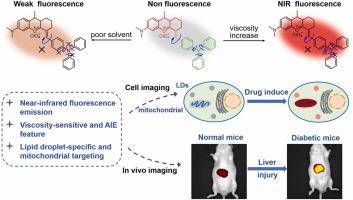当前位置:
X-MOL 学术
›
Sens. Actuators B Chem.
›
论文详情
Our official English website, www.x-mol.net, welcomes your
feedback! (Note: you will need to create a separate account there.)
A near-infrared aggregation-induced emission probe for imaging lipid droplet and in vivo visualization of diabetes-related viscosity variations
Sensors and Actuators B: Chemical ( IF 8.0 ) Pub Date : 2023-07-24 , DOI: 10.1016/j.snb.2023.134347 Huili Wang , Hongyong Zheng , Wenjing Zhang , Lei Yang , Mingming Yu , Zhanxian Li
Sensors and Actuators B: Chemical ( IF 8.0 ) Pub Date : 2023-07-24 , DOI: 10.1016/j.snb.2023.134347 Huili Wang , Hongyong Zheng , Wenjing Zhang , Lei Yang , Mingming Yu , Zhanxian Li

|
As a pivotal parameter of microenvironment, viscosity is closely related to many diseases and dysfunction in vivo. Lipid droplets, as organelles that store and metabolize lipids, are involved in various physiological processes related to metabolism in cells. Diabetes is one of the metabolic diseases that may lead to dysfunction of organs, which is associated with abnormal viscosity changes. It is of great significance for the study of related diseases to clarify the relationship between viscosity variations in vivo and monitor the changes of lipid droplets. Here, a near-infrared fluorescent probe DPX ((E)− 6-(dimethylamino)− 4-(4-(diphenylamino)benzylidene)− 9-methyl-1,2,3,4-tetrahydroxanthylium) with AIE characteristics was designed, which shows an “off-on” fluorescence response to viscosity based on twisting intramolecular charge transfer (TICT) mechanism. The probe DPX features excellent mitochondria and lipid droplets targeting, and sensitively monitor accumulation of LDs induced by oleic acid and mitochondrial viscosity variations in HeLa cells. More importantly, DPX has been successfully applied to visualize viscosity changes of diabetic liver injury in vivo, which may be benefit for development of diabetes related clinical research.
中文翻译:

一种近红外聚集诱导发射探针,用于脂滴成像和糖尿病相关粘度变化的体内可视化
粘度作为微环境的关键参数,与体内许多疾病和功能障碍密切相关。脂滴作为储存和代谢脂质的细胞器,参与细胞内代谢相关的各种生理过程。糖尿病是可能导致器官功能障碍的代谢性疾病之一,与异常的粘度变化有关。阐明体内粘度变化的关系、监测脂滴的变化对于相关疾病的研究具有重要意义。本文设计了具有 AIE 特性的近红外荧光探针 DPX ((E)− 6-(二甲氨基)− 4-(4-(二苯氨基)亚苯亚甲基)− 9-甲基-1,2,3,4-四氢黄基鎓) ,它显示了基于扭转分子内电荷转移 (TICT) 机制的对粘度的“关-开”荧光响应。探针 DPX 具有出色的线粒体和脂滴靶向性,可以灵敏地监测 HeLa 细胞中由油酸和线粒体粘度变化引起的 LD 积累。更重要的是,DPX已成功应用于体内糖尿病肝损伤的粘度变化可视化,这可能有利于糖尿病相关临床研究的发展。
更新日期:2023-07-24
中文翻译:

一种近红外聚集诱导发射探针,用于脂滴成像和糖尿病相关粘度变化的体内可视化
粘度作为微环境的关键参数,与体内许多疾病和功能障碍密切相关。脂滴作为储存和代谢脂质的细胞器,参与细胞内代谢相关的各种生理过程。糖尿病是可能导致器官功能障碍的代谢性疾病之一,与异常的粘度变化有关。阐明体内粘度变化的关系、监测脂滴的变化对于相关疾病的研究具有重要意义。本文设计了具有 AIE 特性的近红外荧光探针 DPX ((E)− 6-(二甲氨基)− 4-(4-(二苯氨基)亚苯亚甲基)− 9-甲基-1,2,3,4-四氢黄基鎓) ,它显示了基于扭转分子内电荷转移 (TICT) 机制的对粘度的“关-开”荧光响应。探针 DPX 具有出色的线粒体和脂滴靶向性,可以灵敏地监测 HeLa 细胞中由油酸和线粒体粘度变化引起的 LD 积累。更重要的是,DPX已成功应用于体内糖尿病肝损伤的粘度变化可视化,这可能有利于糖尿病相关临床研究的发展。






























 京公网安备 11010802027423号
京公网安备 11010802027423号